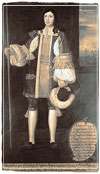History of Santa Fe and Historical Highlights
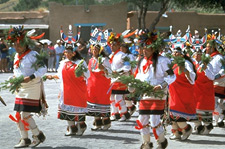 Native
American Indians - In ancient times Santa Fe was a place of
wild beauty. Native people hunted and fished in the mountains and
planted their crops in the fertile valleys. Although the arrival and
eventual domination of Europeans brought religious suppression, military
incursions, and disease to the region's Native American's, their cultures
survived. Today there are eight Indian pueblos with sovereign governments
in northern New Mexico -
VISIT
OUR PUEBLOS PAGE. Indian art fills Santa Fe galleries
and museums. Visiting a pueblo, especially for a ceremonial dance,
is a moving experience. But it is important to observe common courtesy
and a few special rules. Dances are spiritual ceremonies, not spectacles.
It is respectful to refrain from asking questions and to give tribal
members the best views. Don't walk on private property or touch kivas.
Photography is restricted and sometimes prohibited. Go with an open
heart and you will be rewarded with a lasting memory.
Native
American Indians - In ancient times Santa Fe was a place of
wild beauty. Native people hunted and fished in the mountains and
planted their crops in the fertile valleys. Although the arrival and
eventual domination of Europeans brought religious suppression, military
incursions, and disease to the region's Native American's, their cultures
survived. Today there are eight Indian pueblos with sovereign governments
in northern New Mexico -
VISIT
OUR PUEBLOS PAGE. Indian art fills Santa Fe galleries
and museums. Visiting a pueblo, especially for a ceremonial dance,
is a moving experience. But it is important to observe common courtesy
and a few special rules. Dances are spiritual ceremonies, not spectacles.
It is respectful to refrain from asking questions and to give tribal
members the best views. Don't walk on private property or touch kivas.
Photography is restricted and sometimes prohibited. Go with an open
heart and you will be rewarded with a lasting memory.
Spanish - The small group of Spanish settlers who struggled across the baking desert and up the steep mountains to northern New Mexico nearly 400 years ago were a hardy and tenacious lot. To survive in this remote outpost of the Spanish Empire, they drew closely together and established the core values of family and faith that remain at the heart of 21st century Santa Fe. Today, many of their gracious adobe churches and homes still stand and thousands of their descendants ensure that Hispanic culture is just as strong as the adobe walls. Artisans working in styles passed down from their ancestors fill galleries, museums, and shops. Spanish influences are everywhere.
Everyone Else - Ranchers, cowboys, merchants, and pioneers came to explore and sometimes exploit Santa Fe's untamed wilderness. In the early 1800's the region was a mystery to most Americans. Spain closely guarded its territories, keeping foreigners out but then Spanish rule collapsed, the Santa Fe Trail opened, and droves of Americans and Europeans poured in to seek new fortunes. Railroads arrived and tales of this exotic land brought the first tourists. Soon artists from all over the world moved to Santa Fe, bringing their bohemian flair and establishing the city's reputation as an art colony.
|
10,000
B.C. Nomadic Pueblo Indians
inhabit the region.
|
||||
| The First Americans - In ancient times Santa Fe was a place of wild beauty. Native people hunted and fished in the mountains and planted their crops in the fertile valleys. They built multistoried dwellings, had complex societies and governments, and journeyed along far-flung trading routes. Their artistry transformed even the most ordinary objects, and their spirituality wove through every aspect of their lives. Although the arrival and eventual domination of Europeans brought religious suppression, military incursions, and disease to the region's Native Americans, their cultures survived. Today there are 19 New Mexico Indian Pueblos with sovereign governments in northern New Mexico. Indian art fills Santa Fe galleries and museums, and Indian people make countless contributions at every level. Visiting a pueblo, especially for a ceremonial dance, is a moving experience. But it is important to observe common courtesy and a few special rules. Dances are spiritual ceremonies, not spectacles. It is respectful to refrain fro m asking questions and to give tribal members the best views. Do not walk on private property or touch kivas. Photography is restricted and sometimes prohibited. If you are invited to share food on a feast day, it is polite to accept, but not to linger. Go with an open heart and you will be rewarded with a lasting memory. | ||||
|
D
850 - 1250
Chaco Canyon
was a major ancestral Pueblo Cultural Center.
Remote and isolated, it offers few amenities, so come prepared. You will find that the rewards are unlimited. Chaco Culture National Historical Park preserves one of America's most significant and fascinating cultural and historic areas. |
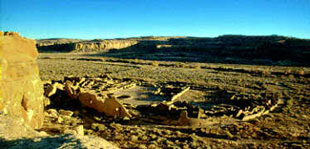 |
|||
| Chaco Culture National Historical Park is a very special place. A thousand years ago in what is now the American Southwest, the Anasazi (a Navajo word meaning "ancient ones" or possibly "ancient enemies") built dramatic adobe dwellings, or pueblos. Chaco Canyon was the center of Anasazi civilization, its many large pueblos probably serving as administrative and ceremonial centers for a widespread population. It was a hub of ceremony, trade, and administration for the prehistoric Four Corners area - unlike anything before or since. Chaco is remarkable for its monumental public and ceremonial buildings, and its distinctive architecture. To construct the buildings, along with the associated Chacoan roads, ramps, dams, and mounds, required a great deal of well organized and skillful planning, designing, resource gathering, and construction. The Chacoan people combined pre-planned architectural designs, astronomical alignments, geometry, landscaping, and engineering to create an ancient urban center of spectacular public architecture - one that still amazes and inspires us a thousand years later. | ||||
|
||||
|
||||
|
1610 Santa Fe is established as the capital of the Spanish colony. 1680 Pueblo Indians revolt and expel the Spanish.
1692
Don Diego de Vargas leads the reconquest of New Mexico. |
||||
|
||||
|
1821 Spanish rule ends; New Mexico is part of Mexico; the Santa Fe Trail opens. 1846 During the war with Mexico, the U.S. claims New Mexico. 1876
Railroads come to Santa Fe. 1912 New Mexico becomes the 47th American state. |
||||

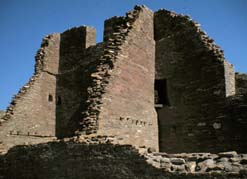
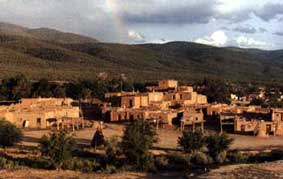
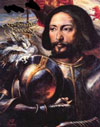 1540
1540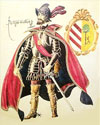 1598
1598